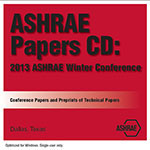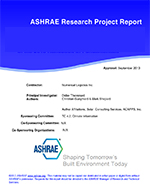Building envelope failures that occurred in recent years in the region of southern British Columbia (BC) promoted the adoption
of rainscreen principle in both rehabilitation and new construction. An air cavity behind the cladding would provide a capillary
break and allow water that may penetrate the cavity accidentally to drain out. Some drying would also occur through
ventilation if vents are provided at both the top and the bottom of the cavity. Existing research has indicated that ventilation helps
drying in certain climates, but how beneficial it is to the damp southern BC climate, characterized by long periods of rain and
wetting, is unknown. Current practice varies in terms of specifying cavity depth and slot vent heights for panel systems. A research
program is developed to study the influence of design details on the drying performance of building envelope systems through
analysis and field measurements.
A simplified method is applied to estimate the drying provided by cavity ventilation for a stucco wall under steady-state conditions,
assuming that the sheathing panel stays wet. The analysis shows that the cavity depth and vent size have a positive impact
on the airflow rate in the cavity; however, the amount of moisture removed by the ventilation is governed by the properties of the
sheathing membrane once the airflow rate reaches a threshold value. For panel systems, an air cavity depth of 19 mm (3/4â€Â)
provides higher airflow and drying rates compared to a 10 mm (3/8â€Â) cavity. For cavity depths greater than 19 mm (3/4â€Â), higher
ventilation rates can be achieved through larger vent openings, but the drying rates are not significantly influenced. A similar
trend is observed from simulation results using a commercially available computer program. Two wetting conditions are investigated,
the first assuming an initially wet sheathing panel, and the second assuming 1% rain leakage into sheathing panels. The
simulation results show that ventilation does help drying but that an optimum ventilation rate does exist. Once this optimum ventilation
rate is exceeded, ventilation may induce wetting. Analysis of field monitored data also indicates occurrence of ventilation
wetting due to clear sky radiation. These observations will be verified through field measurements of full-scale wall assemblies
on a two-story building envelope test facility under controlled indoor and realistic outdoor conditions.
Presented at Thermal Performance of Exterior Envelopes of Whole Buildings X – December 2007
Units: Dual
Citation: Thermal Performance of Exterior Envelopes of Whole Buildings X
Product Details
- Published:
- 2008
- Number of Pages:
- 10
- File Size:
- 1 file , 3.1 MB
- Product Code(s):
- D-BldgsX130


